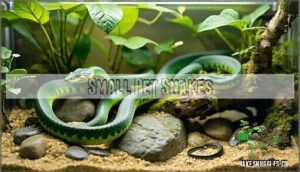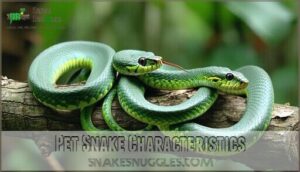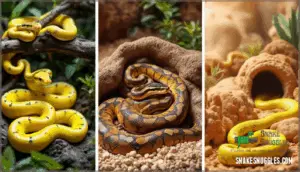This site is supported by our readers. We may earn a commission, at no cost to you, if you purchase through links.
 If you’re starting your snake journey, you’ve got solid options that won’t break your spirit or wallet.
If you’re starting your snake journey, you’ve got solid options that won’t break your spirit or wallet.
Corn snakes top most best pet snake guide lists because they’re forgiving and colorful.
Ball pythons bring calm energy but need precise humidity.
King snakes pack personality in smaller packages, while milk snakes offer vibrant patterns without fussy care requirements.
These species handle beginner mistakes gracefully and don’t demand expert-level husbandry.
You’ll want snakes under four feet for easier management and lower costs.
Each species brings unique traits that match different lifestyles and experience levels—discovering which personality clicks with yours changes everything.
Table Of Contents
- Key Takeaways
- Choosing Best Pet Snake
- Snake Care Basics
- Pet Snake Characteristics
- Snake Species Overview
- Selecting Right Pet Snake
- Frequently Asked Questions (FAQs)
- What is the best pet snake?
- What are the best snakes for beginners?
- Are snakes a good pet for beginners?
- What is a good pet snake for kids?
- What snakes are easy to care for?
- What is the most friendly snake for a pet?
- What should my first pet snake be?
- What is the most cuddly pet snake?
- Which snakes like to be handled the most?
- What veterinary costs should snake owners expect?
- Conclusion
Key Takeaways
- You’ll want beginner-friendly species that handle mistakes gracefully – corn snakes, ball pythons, king snakes, or milk snakes won’t punish you for learning curve errors
- Choose snakes under four feet for easier management and lower costs – smaller species require less space, food, and money while still delivering personality and visual appeal
- Master three care basics to keep your snake healthy – consistent feeding schedules with frozen-thawed rodents, proper temperature gradients (85-90°F basking, 70-75°F cool), and 50-70% humidity levels
- Match the snake’s personality to your lifestyle – corn snakes offer colorful reliability, ball pythons bring calm energy, while king and milk snakes pack vibrant patterns with straightforward care needs
Choosing Best Pet Snake
Choosing the right pet snake requires considering your experience level and lifestyle needs.
Beginner-friendly species like corn snakes and ball pythons offer docile temperaments and straightforward care requirements that make them ideal first reptile companions, with ball pythons being particularly popular for their ease of care.
Beginner-Friendly Species
Looking for the best pet snake as a first-time owner? These docile snake species make perfect companions for beginners ready to embrace reptile ownership.
Here are four top beginner snakes worth considering:
- Corn snakes – docile temperament with 10-20 year lifespans
- Ball pythons – calm demeanor and captive bred availability
- Rosy boas – low maintenance with easy handling requirements
- King snakes – small size and straightforward snake care guide needs
These easy to care snakes offer manageable commitment levels for new keepers.
Some species, like corn snakes, are known for being easy to care for, requiring minimal humidity and heat.
Small Pet Snakes
Small pet snakes offer perfect starter companions for new reptile enthusiasts.
Ringneck snakes reach just 10-15 inches while smooth green snakes max out at 20 inches.
These docile snake species require minimal enclosure size compared to larger breeds.
Rosy boas are notorious escape artists despite their peaceful temperament variety.
Kenyan sand boas dislike frequent handling frequency but remain even-tempered.
These easy to care snakes showcase significant lifespan differences—ringnecks live six years while rosy boas thrive for decades.
Popular Pet Snake Species
Four pet snake types dominate the reptile world for good reason.
Corn snakes lead with exceptional beginner appeal and countless morphs from captive breeding programs. Ball pythons offer incredible temperament traits and morph availability spanning 500+ variations. California kingsnakes provide hardy dispositions with striking patterns.
Their global distribution and established breeding make these popular pet snakes accessible worldwide.
- Corn snakes feature docile temperaments with 15-20 year lifespans and vibrant color morphs
- Ball pythons live 20-30 years with over 500 recognized morphs from extensive captive breeding
- California kingsnakes display natural resistance to other snake venoms with manageable 3-4 foot sizes
- King and milk snakes offer low-maintenance care with striking banded patterns and hardy constitutions
- Rosy boas provide 30+ year lifespans with calm behavior and beautiful regional color variations
Snake Care Basics
Proper snake care starts with understanding three essential elements that keep your pet healthy and comfortable.
You’ll need to master feeding schedules, temperature control, and moisture levels to create an environment where your snake can thrive.
This involves managing the environment to ensure it meets the snake’s needs, which is crucial for its well-being.
Dietary Needs
Your pet snake’s diet centers on whole prey that matches their natural feeding patterns.
Most species thrive on frozen-thawed rodents, which offer convenience and safety compared to live prey.
Frozen-thawed rodents deliver safe, convenient nutrition without the bite-back risks of live prey.
Prey size should equal your snake’s thickest body section.
Feeding frequency varies by age—juveniles eat weekly while adults feed every two weeks.
Adult corn snakes consume mice, while ball pythons handle slightly larger rats.
Supplementation isn’t necessary with whole prey diets since they provide complete nutrition.
Heating Requirements
Why do snakes need specific temperatures to thrive?
Your snake enclosure requires a temperature gradient with basking temperature reaching 85-90°F and cool zones at 70-75°F.
Heat sources like under-tank pads or ceramic emitters work best with thermostat control.
Night temperatures can drop to 65-70°F safely.
Proper snake temperature control prevents digestive issues and stress in your snake habitat.
Snakes require a proper thermal gradient to mimic natural behavior.
Humidity Levels
Maintaining proper humidity for snakes prevents shedding issues and respiratory infections while meeting their hydration needs.
Most species thrive between 50-70% humidity in their snake enclosure. Monitor levels with digital hygrometers and adjust misting frequency accordingly.
Choose moisture-retentive substrate like coconut coir for stable snake humidity. A digital hygrometer helps to accurately measure snake enclosure conditions.
Ball pythons need 50-60% normally, increasing to 70-80% during sheds for ideal snake care with a focus on stable humidity.
Pet Snake Characteristics
Understanding pet snake characteristics helps you make an informed choice that matches your experience level and lifestyle preferences.
Key traits like temperament, handling tolerance, and available color variations directly impact your daily care routine and long-term satisfaction as a snake owner.
Docile Temperaments
Understanding snake temperament helps you choose the right companion for your lifestyle.
Gentle handling becomes second nature when you select calm species known for their docile nature.
Here are four key docility factors to keep in mind:
- Snake personality varies by species – Corn snakes and ball pythons naturally exhibit peaceful behaviors
- Individual temperament matters – Even within docile breeds, some snakes show more skittish tendencies
- Age influences behavior – Younger nonvenomous snakes often display more defensive reactions than adults
- Training snakes through consistent interaction – Regular gentle contact helps build trust over time
Handling Requirements
Proper snake handling requires patience and respect for your pet’s boundaries. Start slowly with short sessions to build trust. Never grab from above – snakes interpret this as predator behavior.
Remember to always support snake bodies during handling.
| Handling Aspect | Best Practice |
|---|---|
| Frequency | 2-3 times per week maximum |
| Duration | 10-15 minutes for beginners |
| Timing | Wait 48 hours after feeding |
Watch for stress signs like rapid breathing or defensive posturing. Support your snake’s body weight when lifting. Safe techniques involve approaching from the side and moving confidently but gently.
Color Morphs
Color morphs transform ordinary snakes into stunning varieties through selective breeding and morph genetics.
Selective breeding creates living art – transforming basic snakes into breathtaking genetic masterpieces through careful morph development.
You’ll find snake colors ranging from vibrant yellows to pure whites, with pattern variations creating unique snake species combinations.
Regional morphs develop naturally while breeders create new snake morphs through careful genetic planning.
Rarity factors drive prices—some snake varieties cost thousands due to their exceptional snake patterns and limited availability in the pet trade, making selective breeding and morph genetics crucial factors.
Snake Species Overview
Now you’ll get a detailed look at the most popular pet snake species that make excellent companions for both beginners and experienced keepers.
Each species offers unique characteristics regarding size, temperament, and care requirements that can help you make the right choice for your situation, considering complete concepts about the species.
Corn Snakes
Among all beginner snakes, corn snakes reign supreme for new reptile keepers.
These docile beauties showcase stunning Cornsnake Morphs from classic orange to exotic lavender patterns.
Your corn snake thrives with basic snake care including proper heating and weekly feeding.
Cornsnake Health remains robust with minimal veterinary needs.
Simple Enclosure Enrichment like hiding spots satisfies their natural behaviors, making these pet snakes perfect starter reptiles.
Ball Pythons
With over 500 morph variations available, the ball python stands as a top choice among beginner snakes.
You’ll appreciate their docile temperament and manageable size, though temperament training through regular handling helps build trust.
Snake care involves maintaining proper snake enclosure temperatures and managing snake feeding schedules carefully, as ball pythons can be finicky eaters.
Their breeding potential and stunning morphs make them collectible, while awareness of common illnesses guarantees long-term health, ensuring the snakes remain healthy through proper care.
King Snakes
King snakes make excellent snake pets for beginners thanks to their striking appearance and adaptable nature.
The california kingsnake features bold black and white stripes that create stunning visual appeal.
These snake species showcase amazing King Snake Morphs including chocolate, lavender, and banana variations.
Their calm temperament makes snake care straightforward, though Temperament Variations exist between individuals.
Proper Handling Techniques involve supporting their body weight confidently.
Regional Varieties across North America offer different color patterns.
Basic Enclosure Enrichment with hiding spots satisfies their ground-dwelling preferences perfectly.
Milk Snakes
Milk snakes offer striking beauty with their red, black, and yellow bands that mimic venomous coral snakes.
These pet snakes display remarkable regional variations across the Americas, creating diverse Milk Snake Morphs for snake beginners to explore.
While initially skittish, their temperament changes improve with consistent handling and proper snake care. You’ll need adequate Enclosure Size since they can reach six feet.
Their diet includes rodents and other small animals. Their conservation status remains stable, making them accessible snake species for dedicated owners.
Selecting Right Pet Snake
Before you pick your perfect snake, you’ll need to take into account several key factors beyond just choosing a species.
Your decision should account for the snake’s expected lifespan, your local laws, housing needs, and long-term feeding costs.
This decision requires careful consideration of multiple elements to ensure you make an informed choice.
Longevity Considerations
Snake longevity factors matter when choosing your pet companion.
Species lifespan varies dramatically between different snakes.
Corn snakes live 15-20 years while ball pythons can reach 30 years.
Genetic factors influence lifespan alongside proper husbandry impact.
Good snake care longevity factors include consistent temperatures and appropriate feeding schedules.
Common ailments like respiratory infections reduce snake pet longevity.
Planning for end-of-life care guarantees your snake lives comfortably throughout its entire lifespan.
Location Laws
Location laws for pet snakes vary substantially across the country.
About 20 states permit ownership with permits, while others ban venomous species outright.
Before purchasing your snake, check these critical requirements:
- State Regulations – Some states ban large constrictors over 12 feet
- Local Ordinances – Cities often enforce stricter rules than states
- Banned Species – Native reptiles may require special permits
- Permit Requirements – Venomous snakes typically need licensing
Research exotic pet laws thoroughly before committing to snake ownership.
Enclosure Requirements
Your snake’s home sets the stage for its wellbeing. Tank size matters most – a 20-gallon long works for smaller species like hognose snakes, while larger pythons need 40+ gallons.
For appropriate housing, consider snake tank dimensions to ensure the best fit for your pet. Choose substrate types like aspen shavings or cypress mulch for burrowing species.
Create a proper temperature gradient with basking spots at 85-90°F and cooler areas at 75-80°F. Add hiding spots on both warm and cool sides plus enrichment items like branches for climbing species.
Feeding Management
Proper feeding management forms the backbone of successful snake ownership.
You’ll need to match prey size to your snake’s girth and establish consistent feeding schedules.
Most snakes thrive on frozen-thawed rodents every 7-14 days.
Prey options vary depending on the snake’s size and species.
Overfeeding risks obesity while live prey can injure your snake.
Understanding your snake’s feeding habits guarantees prime health and prevents common dietary mistakes.
Frequently Asked Questions (FAQs)
What is the best pet snake?
For beginners, you’ll find corn snakes are your best choice. They’re docile, easy to handle, and reach a manageable 3-5 feet. Ball pythons offer stunning morphs but need patient trust-building.
What are the best snakes for beginners?
You’ll thrive with corn snakes, ball pythons, or kingsnakes as your first serpent companion. These docile species forgive beginner mistakes, eat readily, and won’t overwhelm you with complex care requirements.
Are snakes a good pet for beginners?
Dipping your toes into the reptile world can feel overwhelming, but you’ll find certain snake species make excellent starter pets.
Corn snakes, ball pythons, and rosy boas offer docile temperaments and straightforward care requirements for newcomers.
What is a good pet snake for kids?
Corn snakes make excellent pets for kids. They’re docile, easy to handle, and rarely bite. These colorful snakes grow 3-5 feet long and live 15-20 years with proper care.
What snakes are easy to care for?
Say your daughter wants a snake that won’t stress her out.
You’ll want corn snakes, ball pythons, or rosy boas.
They’re docile, forgiving with mistakes, and don’t need complex care routines like exotic species do.
What is the most friendly snake for a pet?
Ball pythons top the list for friendliness among pet snakes.
They’re naturally docile with calm temperaments that make handling enjoyable.
You’ll find they rarely bite and become comfortable with regular, gentle interaction over time, showcasing their docile nature.
What should my first pet snake be?
Choose a corn snake for your first pet snake.
They’re docile, easy to care for, and handle well.
These snakes reach 3-5 feet, live 15-20 years, and come in beautiful color variations that’ll captivate you.
What is the most cuddly pet snake?
Want a truly cuddly snake companion?
Ball pythons top the list for their calm nature and tolerance for gentle handling.
They’re docile, rarely bite, and actually seem to enjoy human contact once they trust you.
Which snakes like to be handled the most?
Corn snakes and ball pythons enjoy handling most, staying calm during interaction.
Rosy boas and California kingsnakes also tolerate frequent handling well.
You’ll find these species become comfortable with regular, gentle contact sessions.
What veterinary costs should snake owners expect?
Your wallet better be ready. Routine checkups cost $40-50, but serious issues like respiratory problems run $100- Consider pet insurance for unexpected emergencies that’ll break your budget otherwise.
Conclusion
Like choosing the perfect first car, selecting your ideal snake sets the foundation for years of reptilian companionship.
This best pet snake guide has shown you four exceptional species that forgive mistakes while delivering unique personalities.
Corn snakes offer colorful reliability, ball pythons provide calm presence, and king or milk snakes bring vibrant charm to smaller spaces.
Each species handles beginner errors gracefully without demanding expert-level care.
Your perfect match depends on your lifestyle, space, and preferred temperament—but any of these choices will reward you with a fascinating, low-maintenance companion.
- https://www.petmd.com/reptile/popular-pet-snake-species
- https://www.chewy.com/education/reptile-and-amphibian/snake/best-pet-snakes
- https://www.petsmart.com/learning-center/reptile-care/snake-care-guide-how-to-take-care-of-a-pet-snake./A0042.html
- https://www.webmd.com/pets/getting-a-pet-snake
- https://www.reddit.com/r/snakes/comments/t2ivfc/a_guide_to_your_first_snake/















